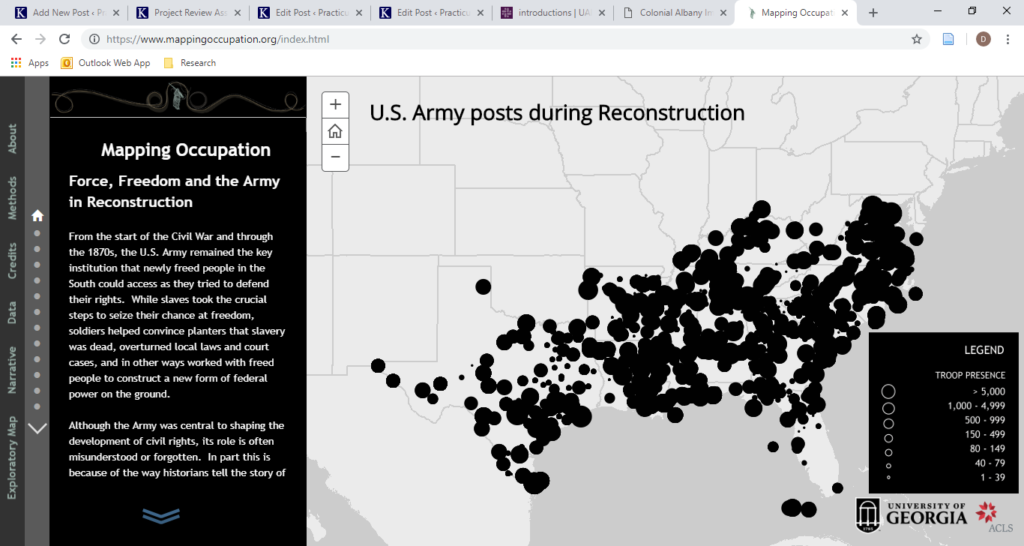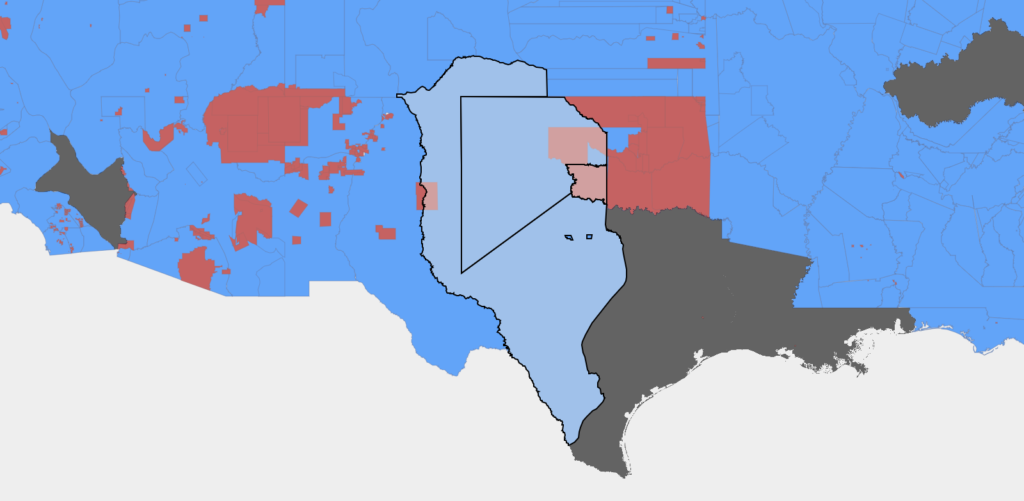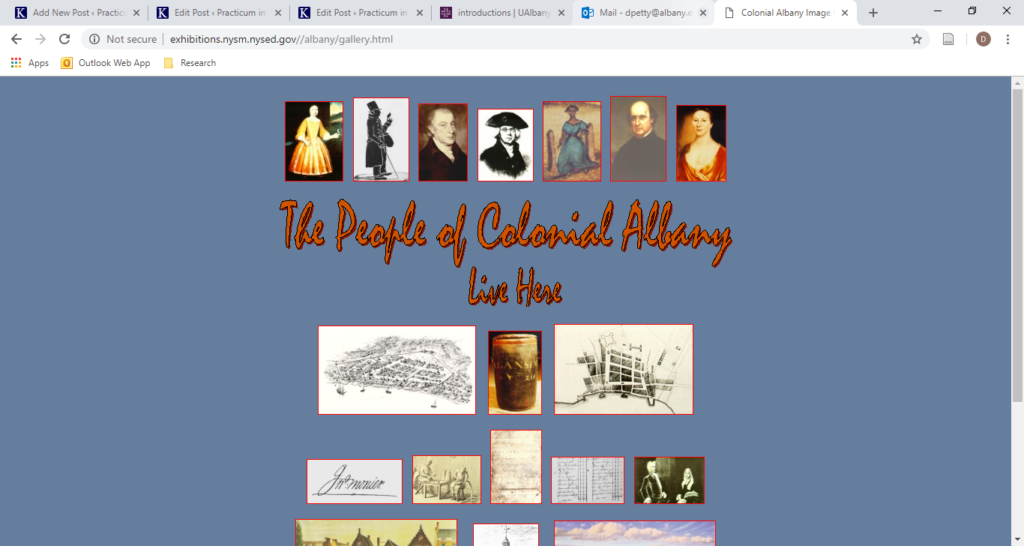Project Critiques
-
Mapping Occupation Review
“Mapping Occupation: Force, Freedom, and the Army in Reconstruction”.
http://mappingoccupation.org. Created by Gregory P. Downs and Scott Nesbit. Maintained by the University of Georgia. https://www.mappingoccupation.org/map/static/credits.html. Reviewed February 5, 2019.
Narrative Screen of Mapping Occupation -
Review of Invasion of America
Jesse Aragona
http://usg.maps.arcgis.com/apps/webappviewer/index.html?id=eb6ca76e008543a89349ff2517db47e6/. Project Director: Claudio Saunt, Russell Professor of History at the University of Georgia. Reviewed, Made for eHistory.org. Reviewed Feb 4 2019
Invasion of America is an interactive map of the United States, showcasing the westward push of settlers into America’s heartland while also showing the loss of Native Lands. The map consists of three colors, the gray is unceded territory, the blue is for Native lands, and lastly the red represents reservations. The map itself is a simple as it is effective, allowing the user to add or remove layers, adjust for time to view the contemporary or the historical, and even has a search system to locate individual nations within the map itself. Beyond features unique to this project the map has standard zoom, and movement features that any standard digital map has, allowing for adjustment to the screen. The details however are what give this project its meaning as the map allows those who interact with it to watch a visual representation of the losses experience by Natives at the hands of the ever-expanding United States. The ability to track specific tribes allows for a more intimate look at this process, helping to break down the mass of loss of land and life into a more easily digested smaller chunk. Allowing for this break down not only allows a closer look at the individual nations, but also does an excellent job of maintaining the necessary scope to tackle such a vast project. Aside from the visuals, the project also provides a rather well written introduction about the map itself and the events it describes. The importance of this project isn’t lost in its appealing visuals and interactive design, instead the map itself serves as a grim reminder of an incredibly dark, and rarely discussed chapter in America history. Remembering the tragic events of our nation’s past against the back drop of the current state of Native affairs in regards to reservations is a stark reminder for all of us to do better to help those marginalized.

The map as a whole 
Using the search tool to find the Kiowa Nation -
The People of Colonial Albany Review
“The People of Colonial Albany: A Community History Project.” https://exhibitions.nysm.nysed.gov/albany/. Created and maintained by the New York State Museum, Albany, New York, (https://exhibitions.nysm.nysed.gov/albany/whoarewe.html). Reviewed February 5, 2019.

Home Screen of The People of Colonial Albany -
Review: Layers of London
Layers of London. https://www.layersoflondon.org/. Funded by the Heritage Lottery Fund and developed by the University of London’s Institute of Historical Research. Reviewed February 4, 2019.
Developed by the University of London’s Institute of Historical Research, Layers of London is an interactive webpage that with collaboration from institutions across London and Britain, allows a user to interact with a map of the city. The map includes all sorts of pictures of various locations around the city including homes, churches, schools, and other landmarks. The interactive map is easy to use and the search function included in the map allows for the user to easily find what they are looking for.
-
Review: The University at Albany Campus Buildings Historic Tour.
The University at Albany Campus Buildings Historic Tour is a site that allows for the user to learn about the history of the campuses. This includes former campuses, downtown campus, Alumni Quadrangle, Uptown campus, and East campus.
The way the site operates the information is devoting a section to each area of UAlbany with various amounts of posts in each section. Each post for a building includes a picture, along with a short write up to describe the history of the building. The write ups are definitely the strongest aspect of this site. Each blurb is very informative, but also succinct which allows for the user to not get bogged down on any one page. Navigation on the site is simple as the interface allows the user to easily click on the section they want to learn about.
-
Project Review: Canals 1820-1860

Canals 1820-1890 Canals 1820-1860 is an interactive map that shows the overtime construction of canals in antebellum America. Drawing from primary sources and histories, Canals 1820-1860 aims to show the importance of America’s canal system to the development of a shared “Northern” identity.
-
Project Review: The Viral Texts Project

“The Country Editor–Paying the Yearly Subscription” by F.S. Church, from Harper’s Weekly (17 January 1874) -
Review: The Welikia Project
Beyond Mannahatta: The Welikia Project. https://welikia.org/. Created by Phillip Pond and maintained by the Mannahatta Project staff at the Wildlife Conservation Society, https://welikia.org/credits/. Reviewed February 3, 2019.
Welikia is Lenape for “my good home”, referring to the island of Mannahatta (Manhattan/Land of Many Hills). It is the center of Eric Sanderson’s project to remap Manhattan and reconnect it to its ecological roots. Reimaging the flora and fauna, recreating farms and habitations, he Welikia Project website aims to break down Sanderson’s project into easily understood, yet wholly fascinating parts.
-
Review: The Normal School Company & Normal School Company History
The Normal School Company & Normal School Company History. .https://www.albany.edu/faculty/aballard/civilwar/index.html. Created by Professor Allen Ballard’s graduate seminar. Reviewed February 3, 2019.
Normal School Company introduces the story of the Company E of the 44th NY, comprised of students, faculty, and alumni of the Albany Normal School. The website has several links, detailing the history of the Normal School, the men of the company, the battles they fought, and the various cemeteries that became the final resting place for the men who fought.
-
Review: Slave Revolt of Jamaica, 1760-1761
Slave Revolt in Jamaica, 1760-1761: A Cartographic Narrative. http://revolt.axismaps.com/map/. Created by Vincent Brown. http://revolt.axismaps.com/. Reviewed February 5, 2019.
Slave Revolt in Jamaica, created by Harvard history professor Vincent Brown, is an animated thematic map that tracks the 1760 slave insurrections in Jamaica. Beginning with the 1760 Tacky’s Revolt, Brown reconstructs the movements of three distinct rebellions that shook the British Atlantic World.